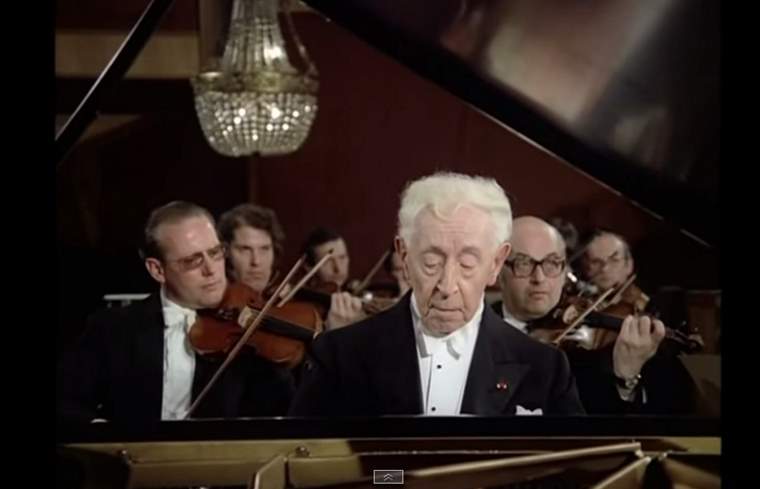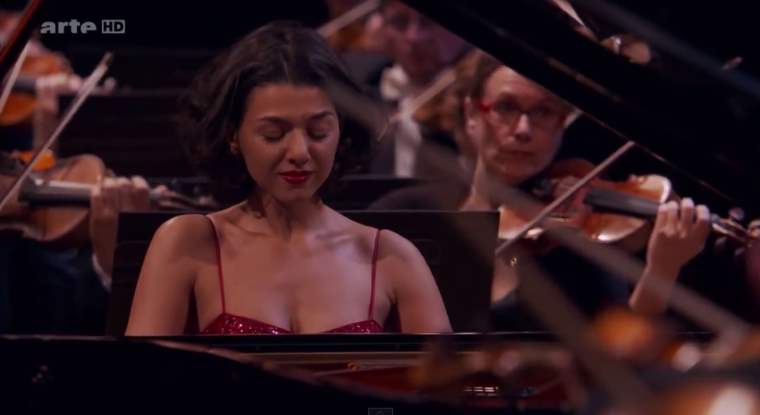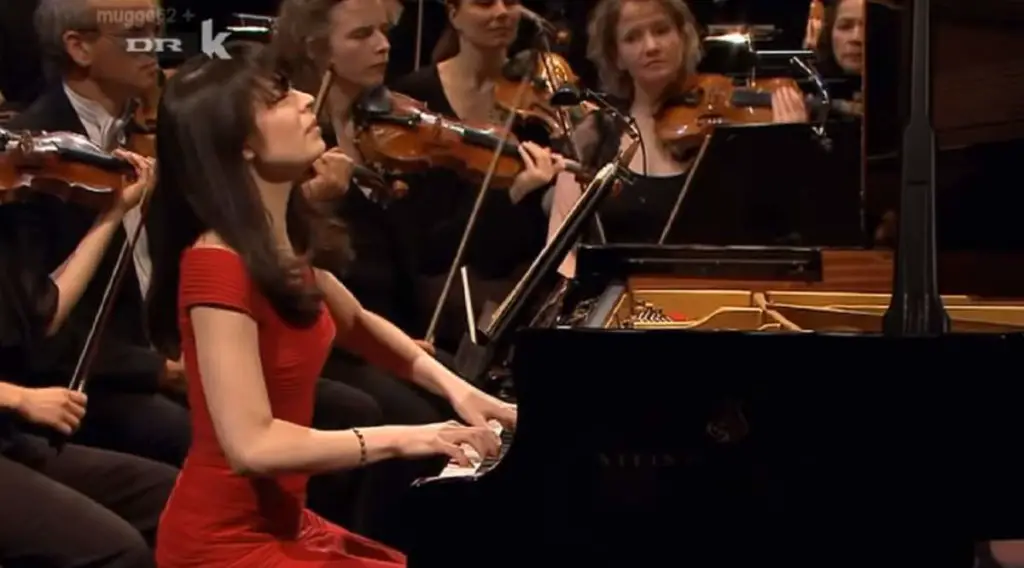Accompanied by the German Youth Philharmonic orchestra, the German classical violinist and pianist Julia Fischer performs Edward Grieg’s Piano Concerto in A minor, Op. 16. Conductor: Matthias Pintscher.
Edward Grieg’s Piano Concerto
Edvard Grieg’s Piano Concerto in A minor, Op. 16, stands as one of the crown jewels of the Romantic piano concerto repertoire. Composed in 1868, when Grieg was just 25 years old, this piece is the only concerto Grieg wrote, and it has enjoyed enduring popularity from its premiere to the present day.
The concerto showcases Grieg’s deep love for his Norwegian homeland, as it is imbued with the spirit and melodic contours of Norwegian folk tunes, even though the themes are original to Grieg. The folkloric influences are evident in the rhythms, harmonic progressions, and the overall lyrical quality of the concerto, which imbues it with a distinctive nationalistic character.
In terms of its structure and thematic development, the concerto has drawn comparisons to Robert Schumann’s Piano Concerto, also in A minor. Schumann’s work profoundly influenced Grieg, and the parallels between the two concertos are palpable, from certain pianistic figures to the overall mood and architecture of the compositions. However, Grieg’s concerto stands on its own merits, with its unique blend of virtuosic flair, deep Romantic expressiveness, and Norwegian character.
One of the most instantly recognizable elements of Grieg’s concerto is its dramatic opening, where the solo piano launches the piece with a cascade of descending chords, setting a precedent for concertos that came after it. Beyond its striking introduction, the concerto is known for its lush orchestration, which allows for a rich interplay between the piano and the orchestra. The soloist part is technically demanding, yet it never feels like empty virtuosity; every note serves the music’s emotive purpose.
In essence, Grieg’s Piano Concerto in A minor captures the heart of Romanticism with its profound expressiveness, while also presenting a musical portrait of Norway through its folk-inspired elements. The work remains a favorite among pianists and audiences alike, celebrated for its melodic beauty, virtuosic challenges, and evocative moods.
Movements
With start times in the video:
- [0:22] Allegro molto moderato
- [10:30] Adagio
- [19:00] Allegro moderato molto e marcato – Quasi presto – Andante maestoso
1. Allegro molto moderato
The first movement of Grieg’s Piano Concerto in A minor, Op. 16, is marked Allegro molto moderato and commences with a flair of drama. Immediately, the soloist captures attention with an arresting cascade of descending chords, an iconic introduction to the piano concerto repertoire. Following this bold beginning, the orchestra introduces a lyrical theme that will be a focal point throughout the movement.
Grieg’s Norwegian heritage shines through in his thematic material. The primary theme, evocative of Norwegian folk melodies though original to Grieg, is presented with a song-like quality. The piano, when it takes the lead, delves into the exploration and embellishment of this theme, frequently engaging in a dialogue with the orchestra. As the movement progresses, it becomes evident that Grieg has managed to encapsulate the essence of Romanticism, blending moments of raw passion with delicate introspection. The solo piano part offers a challenge, laden with rapid runs, intricate figurations, and harmonically rich passages, and the interaction between the soloist and orchestra seamlessly switches between dramatic intensity and lyrical tenderness.
In terms of its structural form, the movement is rooted in the sonata-allegro tradition that was prevalent for the first movements of Romantic period concertos. This entails an exposition where the main themes are presented, a development section that dives deeper into these themes, and a recapitulation that revisits the themes. One of the hallmarks of this movement is the cadenza-a section where the soloist gets to shine without the orchestra, showcasing pure virtuosity.
Grieg’s conclusion to the movement is nothing short of grandeur, with a spirited coda that ties together the rich themes and motifs introduced earlier. Throughout, Grieg’s profound connection to his Norwegian heritage is palpable, with the folk-like melodies and moods painting a vivid picture of his homeland’s landscapes and spirit. It’s a movement that stands as both a tribute to universal Romantic ideals and a testament to Grieg’s unique cultural identity.
2. Adagio
The second movement of Grieg’s Piano Concerto in A minor is marked Adagio. Distinct from the fervor and drama of the first movement, this central section of the concerto embraces a more introspective and serene character.
Opening with muted strings, the movement immediately establishes a tranquil atmosphere. This mood is accentuated when the woodwinds present a heartfelt and melancholic melody, conjuring an almost hymn-like quality. Grieg’s deep admiration for Norwegian landscapes and the serenity of nature seems to echo in this melody, which speaks of gentle nights and still fjords.
Soon after, the piano joins with a touch of elegance and sensitivity. Instead of dominating the texture, as it often did in the first movement, here it complements and converses with the orchestra in a delicate exchange. The thematic material is treated with care, as the piano and orchestra weave in and out of the spotlight, each taking turns to reflect upon and adorn the central theme.
Throughout this movement, Grieg’s emphasis is on emotion and expression rather than virtuosity. There are no grand cadenzas or displays of technical prowess; instead, the music focuses on the depth of feeling and the beauty of simplicity. The orchestration, too, remains relatively sparse, allowing for each instrument’s voice to be distinctly heard and appreciated.
As the movement progresses, there’s a sense of timelessness. Moments of profound reflection are juxtaposed with passages of hopeful optimism. The ending, gentle and subdued, leaves the listener in a state of contemplative stillness, preparing them for the finale that is yet to come.
In the Adagio, Grieg showcases his ability to create deeply touching music that resonates on an emotional level, further solidifying the concerto’s place as one of the most cherished pieces in the Romantic repertoire.
3. Allegro moderato molto e marcato – Quasi presto – Andante maestoso
The finale of Edward Grieg’s Piano Concerto carries the designation “Allegro moderato molto e marcato.” Following the introspective second movement, this finale ushers in a fresh burst of energy and spiritedness, capturing the listener with its vigor and rhythmic vitality.
The movement starts with a lively, dancing theme on the piano, which immediately sets a jubilant tone. This theme, infused with a distinctly Norwegian folk character, is reminiscent of the traditional Halling dance, a folk dance traditionally performed in rural Norway. Grieg’s deep-rooted love for his native Norwegian musical traditions shines prominently here as he incorporates folk-like elements that lend an air of rustic charm and vivacity to the movement.
Throughout the movement, the piano and orchestra engage in a lively dialogue, each echoing and elaborating upon the other’s ideas. The harmonic language is rich and colorful, with Grieg weaving in unexpected modulations that add depth and surprise to the musical journey. There are moments of pure virtuosic display from the soloist, with rapid runs and thrilling passages that demand dexterity and precision.
But it’s not all about exuberance. The movement also has its lyrical moments, with the piano occasionally drifting into more poetic and reflective episodes. These softer sections serve as a brief respite, allowing listeners to catch their breath before being swept away once more by the unbridled energy of the primary theme.
As the movement moves towards its conclusion, there’s a sense of building momentum. Grieg introduces a majestic version of the main theme, with the orchestra and piano uniting in a grand proclamation. This leads to a thrilling finale, marked by bold chords and exhilarating orchestration, culminating in a triumphant and resounding end.
In this final movement, Grieg brilliantly encapsulates a sense of joy and nationalistic pride, offering a fitting conclusion to a concerto that traverses a vast emotional landscape. Through the spirited dance rhythms, intricate interplay between the soloist and orchestra, and moments of lyrical beauty, the third movement serves as a testament to Grieg’s genius and his profound connection to his Norwegian heritage.
Sources
- Piano Concerto (Grieg) on Wikipedia



![Mendelssohn: Violin Concerto [Julia Fischer]](https://cdn-0.andantemoderato.com/wp-content/uploads/2023/04/Julia-Fischer-Mendelssohn-Violin-Concerto-1024x572.jpg)